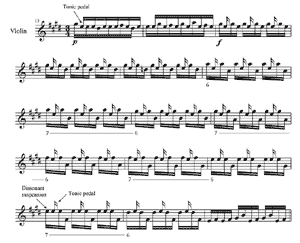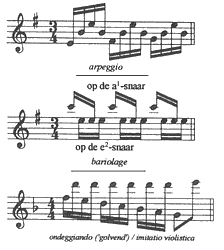Bariolage
With the string instrument technology Bariolage a fast exchange between a constant note and changing notes that form a melody either above or below the steady note meant. This technique is commonly used in Baroque music, where the constant touch usually is an empty string. This has the objective to achieve a maximum resonance in the instrument.
The lower neckline, written for violin, contains Bariolage in the second bar. In this example, an A is (empty string on the violin ) as a consistent touch and an F and an E as changing notes.
A well-known example of Bariolage is Bach's Prelude in E major Partita for the solo violin, in which even three strings are involved ( an empty string and two fretted strings). Other examples are the third set of the summer from the Four Seasons by Antonio Vivaldi or the prelude to the first cello suite by Bach, where Bariolage also occurs in part.
However Bariolage can also mean that the same note, normally an empty string is played resorted to the next lower string. Joseph Haydn used this effect in the minuet of his Symphony No. 28, and also in the finale of his String Quartet 6, Op.50. The rapid change between the open string and the fretted note with the same pitch, but on the other tone color gives the quartet its nickname " The Frog ".
- Playing technique ( string instruments )










